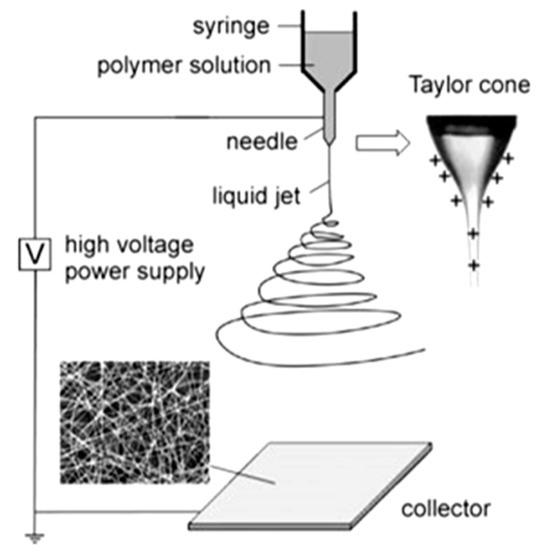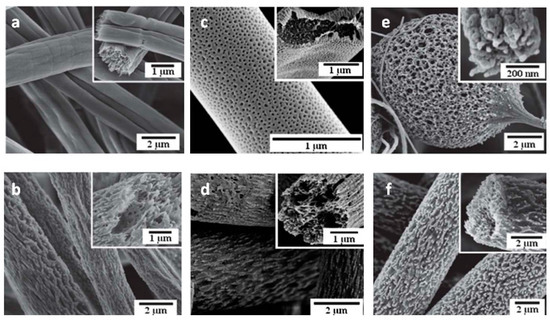1000/1000
Hot
Most Recent

The separation and purification of specific chemicals from a mixture have become necessities for many environments, including agriculture, food science, and pharmaceutical and biomedical industries. Electrospun nanofiber membranes are promising materials for the separation of various species such as particles, biomolecules, dyes, and metals from liquids because of the combined properties of a large specific surface, light weight, high porosity, good connectivity, and tunable wettability. This paper reviews the recent progress in the design and fabrication of electrospun nanofibers for chemical separation. Different capture mechanisms including electrostatic, affinity, covalent bonding, chelation, and magnetic adsorption are explained and their distinct characteristics are highlighted. Finally, the challenges and future aspects of nanofibers for membrane applications are discussed.
In recent years, membrane technologies have obtained great popularity for chemical separations based on their high separation efficiency, simple operational process, and relatively low production cost. A membrane acts like a barrier between two phases and allows a substance to be selectively transferred from one side to the other [1]. It can capture various types of species such as particles, proteins, cells, antibodies, metal ions, and dyes based on their special characteristics (e.g., charge, affinity, size). Membranes have a considerable role in various environmental, agricultural, pharmaceutical, and biomedical applications. They are utilized inside filter devices to purify water, liquids, solutions, and blood for water treatment, artificial kidneys, and control drug delivery applications. They have also been used inside small analytical devices such as biosensors for the in situ analysis of pollutants in crops and soils, the detection and identification of infectious diseases in crops and livestock, and the screening of therapeutic drugs in veterinary testing [2][3][4][5][6].
Nanofiber membranes with a superb surface area to volume ratio, high porosity/tortuosity, and high permeability are an excellent choice for the fabrication of membranes. Several techniques such as nanolithography, phase separation, self-assembly, electrospinning, melt-blowing, and template synthesis have been used for the production of nanofibers. Among them, electrospinning is of particular interest because of its simplicity, versatility, flexibility, and the ease of processing [7]. This technique only requires a syringe, a flat tip needle, a high voltage power supply, and a conducting collector. In terms of flexibility, electrospinning is able to fabricate continuous nanofibers from a wide range of materials such as polymers, composites, semiconductors, and ceramics [7][8][9].
Electrospinning is a fiber formation method in which an electrical field is applied to polymer solutions or polymer melts to produce micro- and nanofibers. A typical electrospinning process comprises three main components: a feeding section, a high voltage power supply, and a collector section (Figure 1). The feeding part comprises a feed storage unit (polymer solution/melt), a spinneret (a thin metallic needle), and a syringe pump to inject the solution/melt at a constant flow/feed rate. The voltage device is used to create an electrically charged polymer solution/melt out of the spinneret [7]. The collector involves a counter or grounded metal electrode attached to a rotating drum or a flat plate. When the electrical feed increases over a critical value, the electrical force overcomes the solution surface tension, and this changes the hemispherical shape of the solution drop at the needle tip into a conical shape known as a Taylor cone, which discharges/ejects a solution jet onto the collector screen. The jet elongates under the electrical field while the solvent evaporates, leaving behind solidified polymer fibers as an interconnected web on the collector [7].

Figure 1. Scheme of the electrospinning process (Reproduced with permission from [10]. Copyright Wiley, 2004).
The effect of the electrospinning conditions on the morphological and structural characteristics of the nanofibers have been discussed in the literature [7][8][11]. The nanofibers’ diameter, shape, and surface topography depend on several solution/melt properties such as viscosity, molecular weight, molecular weight distribution, pH value, polymer conformations, electrical conductivity, surface tension, and the solvent evaporation rate, as well as the processing/spinning conditions, including the geometry and size of the collector mandrel, feed rate, working distance, and strength of the electrical field, and ambient parameters such as temperature, air speed, and humidity [12][13][14]. Manipulating these operating/material conditions can result in different fiber morphologies such as beaded, porous, branched, surface, inner, and hollow structures (Figure 2). Ideal nanofibrous fabrics should have a continuous single nanofiber with a defect-free surface structure and constant and controllable diameters [8].

Figure 2. SEM images of electrospun polystyrene (PS) nanofibers produced at two molecular weights of (a) Mw = 34 KD and (b) Mw = 208 KD [13], morphology of PS nanofibers (Mw = 208 KD) formed from tetrahydrofuran (THF) and dimethylformamide (DMF) solvents: (c) THF/DMF (100/0) (d) THF/DMF (40/60), PS (Mw = 208 KD) fibers nanofibers electrospun from (e) 10% and (f) 30% PS in THF:DMF (80/20 w/w) [13] (Reproduced with permission from [13]. Copyright Elsevier, 2012).
Nanofiber membranes require several properties to be used for chemical separation. Depending on the application, they need to have a high porosity, appropriate pore size, as well as a high mechanical, chemical, and/or thermal resistance, as they may experience different temperatures, pH, stresses, and vibrations in a liquid flow. In addition, a nanofibrous membrane often needs to have a good selectivity and reusability to increase the separation performance and operational flexibility, and to reduce the material and labor costs. Nanofibrous fabrics can separate chemicals and impurities by different capture mechanisms including electrostatic, affinity, covalent bonding, chelation, magnetic, and size exclusion/filtration. The application of electrospun membranes for liquid filtration and oil/water separation have been reviewed by other authors [11][12]. As such, in this contribution, we will focus on the recent development of electrospun nanofibers working with other capture mechanisms.